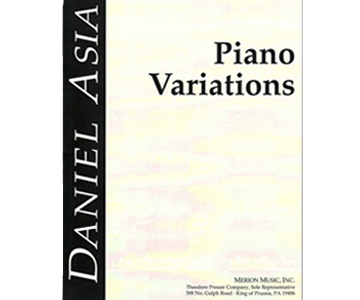Scoring
piano solo
Performances
WEDNESDAY, NOVEMBER 3, 1999
TUCSON, AZ
Tannis Gibson, piano
Crowder Hall
University of Arizona
Tucson, AZ
Program Notes
Piano Variations is a work in four movements. The outer movements are linked by character and material, the latter being a simple variation on the first. The materials of these movements, are alternately majestic, and quiescent, yet both ideas are somewhat of a detached nature, more having to do with the physical world than the human. The second movement is both ethereal and ruminative, alternating materials suggestive of large spaces, open and cavernous, and simple melodies that are elegiac in character. The third movement is whimsical and playful. Toccata-like, it is driven by continuous sixteenth note and eighth note combinations. Occasional intrusions of a more whimsical music occurs, but this is never able to derail the prevailing onward rush of the piece.
The piece was begun in the summer of 1998, and after a long hiatus, finished in August of 1999.
Review
PAUL INGRAM, FANFARE MAGAZINE, NOVEMBER 2004
ASIA Wind Quintet. Brass Quintet. String Quartet No. 2 Dorian Wind Qnt; American Brass Qnt; Cypress Qrt SUMMIT DCD 385 (59:00)
ASIA Breath in a Ram’s Horn. Pines Songs. e. e. cummings Songbook Faye Robinson (sop);1 Robert Swensen (ten); Tannis Gibson (pn) SUMMIT DCD 336; SMT DVD-STS 8000 (53:43)
ASIA/HAAHEIM An Awesome Silent Fire. Mercury. Like Smoke towards Heaven. Chromium. Cry. Sacred and Profane Dance Mix1 Electro-acoustic realisations by the composers SUMMIT DCD 299 (54:27);1 SMT DVD-STS 8001 (45:36)
Daniel Asia rocks. The CD version of “Sacred and Profane” makes a bid for the techno charts with a pumping, eight-minute, sampling dance remix. It’s excellent, and my kids were not embarrassed—a sure indication that Asia and associates really know what they’re doing. More! Sadly, this is not included on the even-shorter-measure DVD version. The only visual enticement there is a series of still-video images by Janet Davidson-Hues, one for each track: artily re-coloured shots of hands, cats, etc. Your home becomes a gallery installation, thanks to Summit. Yet rather more could be done visually. The music, otherwise, is proficient electro-acoustic material, sometimes rhythmically regular, often not. Quite restrained, often gentle, and subtly constructed, “Sacred and Profane” makes a nod to each stage of the history of bleep-music, but finds its own means of distinguishing character and mood, athematically. That mood is rarely sensual, and the sounds do not always avoid the evocation of robotic romance. These pieces were written with Kip Haaheim, who is also involved in musical-medical research. Surround-sound is a plus with swirling electronics like this, but the lack of the dance track on the DVD is near-impossible to fathom. I love this kind of arty thing, so the DVD is still recommended, especially if you have a large room or home in which to let the sounds really float and fly. It grows on you, but in surround, you grow into it . . .
No smooth link, I’m afraid, to help us grow together into the next paragraph: the galactic chasm between S and P and Breath in a Ram’s Horn is bridged only by Asia’s competence and fine ear. Here the composer adopts a friendly idiom to match himself with the great American art-song writers, the Rorems and Barbers of this world. Asia sets varied e. e. cummings and verses by his friend, Paul Pines. The words appear on screen, in the picture-free DVD version, superimposed on . . . exactly the same words, scrolling on-screen. Go figure. But I loved this too! I want all my song records to have arty, scrolling words like this, or I want lots of poetry DVDs, even without the music. Words become objects for visual contemplation in themselves, and for these two poets, that couldn’t be more apt. I’ll field that ball labeled “pretentious” and punt it right back: this Summit DVD makes a fresh experience from the simplest of means. It truly enhances our appreciation of the way words and music work together.
Pines makes fine, personal poetry out of short lines; Asia responds like a true partner. Swenson’s tenor is perfect for the first cycle, familial and elegaic; Robinson’s soprano spans the more challenging lines of the second group, tonally not so ingratiating, but in keeping with the tone of the words and music. Swenson then has to project all the marvelous word- and syllable-orderings of cummings, for which Asia finds plausible musical equivalents, from sing-song and blues, to dirge, keeping Gibson’s lucid piano as busy as your mind. Treat yourself to the DVD for the sake of the words: sound is fine, and surround is not really an issue here.
No format issues for the chamber disc: a trilogy of solid works from the last 20 years, well played and recorded. Best is the feisty 2001 Brass Quintet, another heartening sign that American composers are getting on with the job of building a fresh, meaningful repertoire for the new millennium. Asia is a master of form and Stravinskian counterpoint and energy, too: some of the best post-war British chamber music comes to mind, but without too many Hindemith overtones, and he manages a throwaway finale with enviable ease in each work.
Asia’s sincerity, range, and accessibility demand our attention. Maybe the Summit CD of Asia symphonies makes the best introduction to his world, but the grown-up expressivity and pathos to be found in Breath in a Ram’s Horn point to deepening rewards ahead for listeners who are sharing these interesting times with a fine composer.
